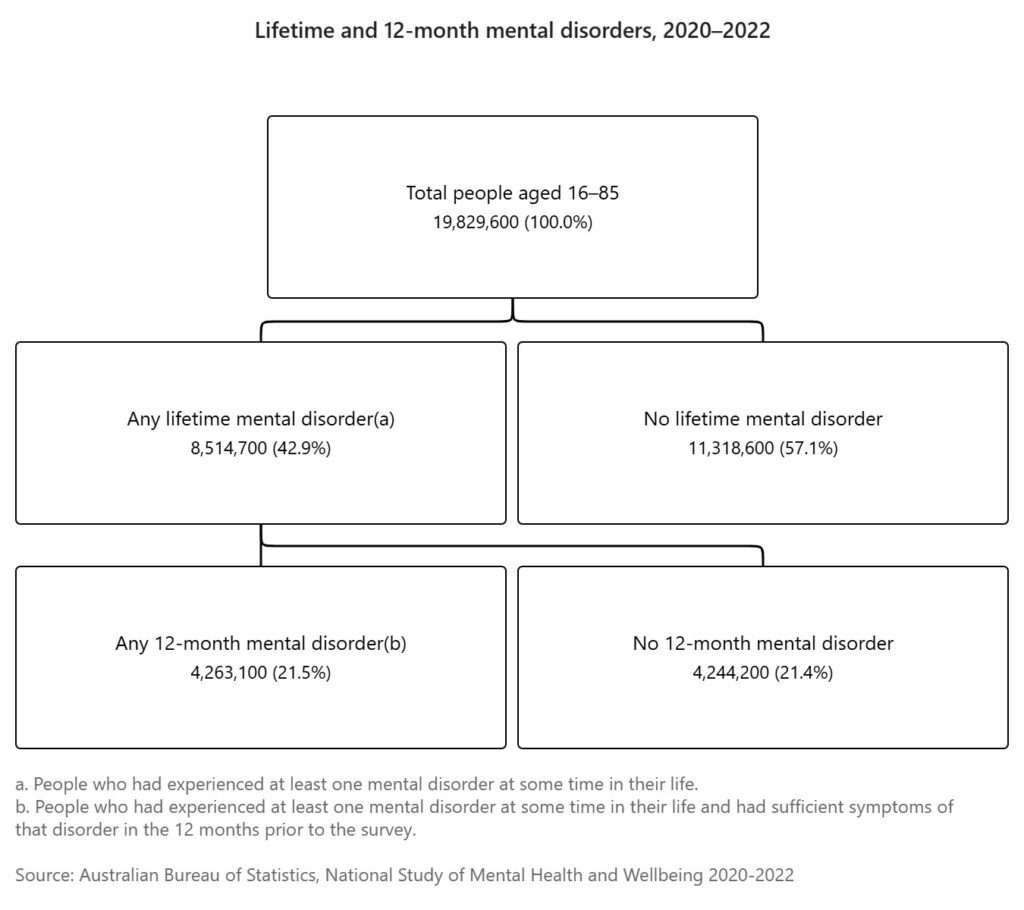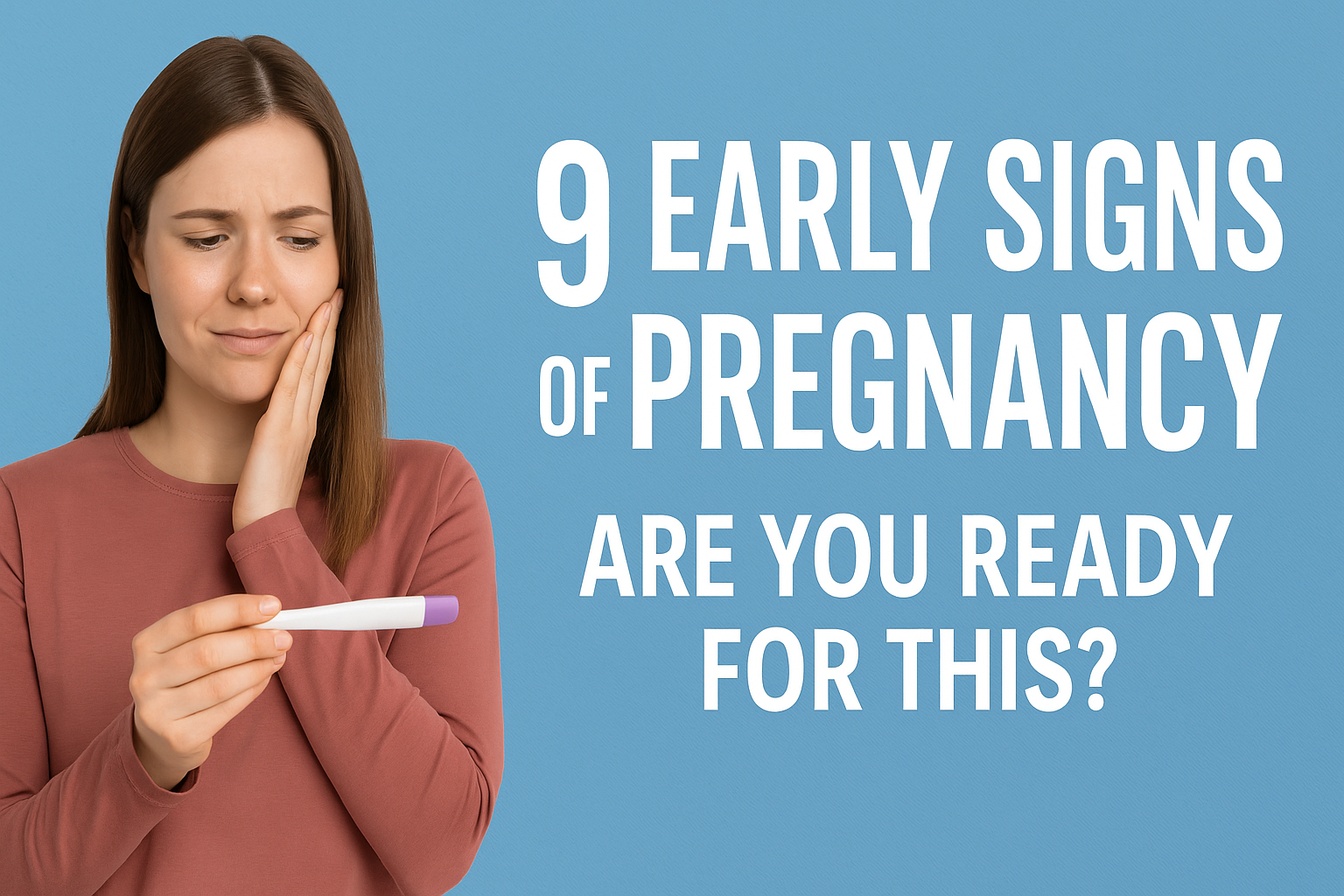Mental health remains a critical public health issue in Australia, affecting a significant portion of the population. This article provides an overview of the latest statistics on psychological health illnesses and outlines the services available to support those in need.
Prevalence of Mental Health Disorders in Australia
- Lifetime Prevalence: According to the Australian Institute of Health and Welfare (AIHW), 43% of Australians aged 16–85 have experienced a mental disorder in their lifetime. AIHW
- 12-Month Prevalence: The National Study of Mental Health and Wellbeing (2020–2022) reports that 22% of Australians aged 16–85 experienced a mental disorder in the previous 12 months, equating to approximately 4.3 million people. AIHW
- Age Variations: Younger individuals are particularly affected, with almost two in five (38.8%) aged 16–24 years experiencing a mental disorder in the past year. Australian Bureau of Statistics
- Gender Differences: Among young people aged 16–24, 45.5% of females and 32.4% of males reported experiencing a mental disorder within the past year. Australian Bureau of Statistics

Common Psychological Health Disorders
- Anxiety Disorders: The most prevalent, affecting 17% of the population aged 16–85 in the past year. AIHW
- Affective Disorders: Including depression, experienced by 8% of Australians in the same age group.
- Substance Use Disorders: Reported by 3% of the population. AIHW
Mental Health Services in Australia

Australia offers a comprehensive range of psychological health services funded by both federal and state governments:
- Medicare Benefits Schedule (MBS): Subsidizes mental health-related services provided by General Practitioners (GPs), psychiatrists, psychologists, and other allied health professionals. Productivity Commission
- Pharmaceutical Benefits Scheme (PBS): Provides access to necessary medications for mental health conditions. Productivity Commission
- Primary Health Networks (PHNs): Coordinate regional mental health services to address local needs. AIHW
- Specialized Mental Health Services: Include inpatient care in hospitals, community-based ambulatory care, and residential care facilities. Productivity Commission
- Non-Government Organizations (NGOs): Such as Beyond Blue, Lifeline, Kids Helpline, and ReachOut, offer crisis support, information, and assistance to individuals experiencing mental health challenges. Productivity Commission
Recent Developments and Budget Allocations
The 2024–2025 Federal Budget has been critiqued for not adequately addressing the scale of mental health issues in the community. Advocates call for increased investment, scalability, and longevity in Psychological health reforms to meet the growing demand for services.
Challenges and the Need for Reform
Despite the availability of services, Australia faces a Psychological health crisis requiring urgent and decisive action. Challenges include long wait times for appointments, particularly in regional areas, and the need for comprehensive reforms to improve accountability, transparency, service delivery, and workforce development.

Conclusion
Psychological health disorders are prevalent across all age groups in Australia, with a notable impact on younger populations. While a range of services is available, there is a pressing need for systemic reforms and increased investment to ensure timely and effective support for all Australians facing mental health challenges.
Read More on Lifestyle and Health






I don’t think the title of your article matches the content lol. Just kidding, mainly because I had some doubts after reading the article.
Your point of view caught my eye and was very interesting. Thanks. I have a question for you.
Reading your article helped me a lot and I agree with you. But I still have some doubts, can you clarify for me? I’ll keep an eye out for your answers.
Thank you for your sharing. I am worried that I lack creative ideas. It is your article that makes me full of hope. Thank you. But, I have a question, can you help me?
Your article helped me a lot, is there any more related content? Thanks!
Your article helped me a lot, is there any more related content? Thanks!
Can you be more specific about the content of your article? After reading it, I still have some doubts. Hope you can help me.
I don’t think the title of your article matches the content lol. Just kidding, mainly because I had some doubts after reading the article.
Your point of view caught my eye and was very interesting. Thanks. I have a question for you.
Your point of view caught my eye and was very interesting. Thanks. I have a question for you.
Can you be more specific about the content of your article? After reading it, I still have some doubts. Hope you can help me.
Thanks for sharing. I read many of your blog posts, cool, your blog is very good.
I don’t think the title of your article matches the content lol. Just kidding, mainly because I had some doubts after reading the article.
Your point of view caught my eye and was very interesting. Thanks. I have a question for you.
Can you be more specific about the content of your article? After reading it, I still have some doubts. Hope you can help me.
Your article helped me a lot, is there any more related content? Thanks!
Thanks for sharing. I read many of your blog posts, cool, your blog is very good.
Thank you for your sharing. I am worried that I lack creative ideas. It is your article that makes me full of hope. Thank you. But, I have a question, can you help me?
Your point of view caught my eye and was very interesting. Thanks. I have a question for you.
Can you be more specific about the content of your article? After reading it, I still have some doubts. Hope you can help me.
Your point of view caught my eye and was very interesting. Thanks. I have a question for you.
Can you be more specific about the content of your article? After reading it, I still have some doubts. Hope you can help me.
Your article helped me a lot, is there any more related content? Thanks!
Your article helped me a lot, is there any more related content? Thanks!
Thank you for your sharing. I am worried that I lack creative ideas. It is your article that makes me full of hope. Thank you. But, I have a question, can you help me?
Your point of view caught my eye and was very interesting. Thanks. I have a question for you.
Thank you for your sharing. I am worried that I lack creative ideas. It is your article that makes me full of hope. Thank you. But, I have a question, can you help me? https://accounts.binance.com/es/register-person?ref=S5H7X3LP
Thank you, your article surprised me, there is such an excellent point of view. Thank you for sharing, I learned a lot.
Your point of view caught my eye and was very interesting. Thanks. I have a question for you.
I don’t think the title of your article matches the content lol. Just kidding, mainly because I had some doubts after reading the article.
Your article helped me a lot, is there any more related content? Thanks!
Your article helped me a lot, is there any more related content? Thanks!
88bet login là chỗ mình đang chơi mỗi ngày. Giao diện ổn, nạp rút ổn định nữa 👌
Can you be more specific about the content of your enticle? After reading it, I still have some doubts. Hope you can help me.
Thank you for your sharing. I am worried that I lack creative ideas. It is your article that makes me full of hope. Thank you. But, I have a question, can you help me?